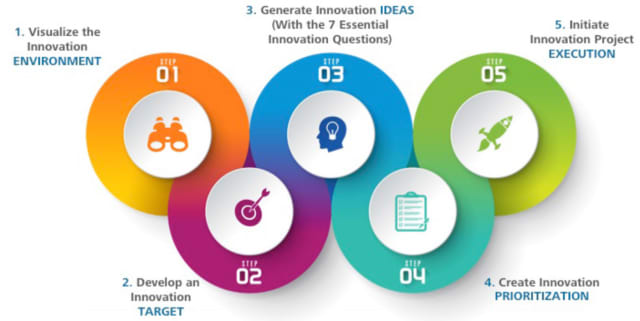Equipment Certification Standards in the Oil and Gas Industry
The oil and gas industry, known for its complex and high-risk operations, demands stringent adherence to various equipment certification standards....
The world of engineering has an obsession with the word “innovation,” with new start-ups popping up every day promising to “innovate” everything from the way we solve problems to the way we practice our design creativity. But, it’s becoming increasingly clear that not every new product or business is innovative.

So, what exactly is innovation? Looking at human history, it’s not hard to call out paradigm-shifting ideas. The Socratic method—that was a big deal. No one can argue about whether penicillin was innovative. And the wheel is basically the paragon of the first innovative idea.

Steps to innovation.
But determining what actually goes into innovation—what goes into the thinking of innovative people—is a bit harder to pin down. What if it were possible to dissect the concept of innovation and come up with a strategy that would enable innovation, and unique engineering solutions on demand?
In this article, we’ll attempt to break down the best thinking behind disruptive inventions and ideas so that you can learn how to become your own on-demand innovator.
What Is Innovation?
Before we can understand how to innovate, we must first understand what innovation is. The Autodesk Innovation Genome project, a massive research effort from Autodesk that looked at 1,000 innovations throughout human history, put forth the following definition:
Innovation is the art of establishing something different or new out in the real world that has a significant impact.
This is a good place to start, but there are a few ambiguities to clear up. First off, what does “different or new” mean? It’s important to recognize that innovation need not be entirely novel. Instead of trying to invent something completely new, it can be much more productive to focus on ways to improve something that already exists. This could be done by finding a more efficient production process, or discovering a lighter material to use in your design. Incremental improvements can be just as innovative as entirely new ideas.
Second, what counts as “out in the real world”? Well, in order to be innovative, something has to be shared with others and put to practical use. For example, the iPhone wouldn’t have been very innovative if Steve Jobs only made one and kept it to himself.
Finally, what counts as a “significant impact”? While this could be relative, a significant impact means that there is a noticeable outcome that results from the innovation. This could be in the form of a stronger product, a faster process, cost savings, or all of the above.
Innovation doesn’t happen by accident. If you’re simply sitting around waiting for inspiration to strike, you’ll be waiting for a long time. Innovation is something that must be ignited, and the way to do it is simple: pick a target.
The target you pick should be an issue that gets your brain buzzing. It could be in a good way—like an idea that excites you—but it might also be a problem that you need to solve. If you find it difficult to come up with an innovation target, ask yourself some leading questions, like the following:
Once you’ve settled on a suitable target, there’s still the tiny matter of actually finding a way to innovate. To help jump-start your creativity, the Innovation Genome project suggests asking yourself seven questions, ordered from the easiest to the most difficult:
After going through the seven questions, you’ve probably come up with a list of potentially innovative ideas. Now, it’s time to pick the one that has the best shot. One way to accomplish this is by sorting your ideas into quadrants based on two criteria: how wild they are (i.e., how unique or unconventional) and how worldly they are (i.e., how practical will they be to implement?).

Rate each idea based on how wild and worldly it is and then divide your ideas into quadrants.
Ideas that rate highly in both categories will end up in quadrant 4, as labeled above. This is your sweet spot, and these ideas will be your strongest. If you don’t have any ideas in this quadrant, quadrants 2 and 3 are your next best bet, and with some refinement, these could potentially be bumped up to quadrant 4. Any ideas that fall in quadrant 1, neither very wild nor very worldly, can be safely discarded.
Now that you’ve picked your priority, it’s almost time to get started. There are a few more helpful steps, however, to really give your idea the steam it needs to succeed:
Enacting your plan is only half the battle. To truly see the impact of your attempt at innovation, you have to look at the results. Make sure to track your project over time and honestly assess its impact. To help engineers with this stage, Autodesk has created a seven-question evaluation based on the Innovation Genome project.
While trying to innovate can sometimes seem like catching lighting in a bottle, the truth is that innovation, like most endeavors, can be studied, understood and practiced. With the Autodesk Innovation Genome project and this e-book, “How to Innovate on Demand”, you can find yourself one step closer to being an innovator yourself.
How to Innovate On-Demand - https://www.autodesk.com/industry/manufacturing/mechanical-engineer/innovate-on-demand-ebook
The oil and gas industry, known for its complex and high-risk operations, demands stringent adherence to various equipment certification standards....
In the dynamic world of engineering, where precision and performance are non-negotiable, Finite Element Analysis (FEA) stands as a game-changer. At...
As every engineer in the field knows, when it comes to standards, API is our go-to when focusing on oil and gas industry operations and procedures -...